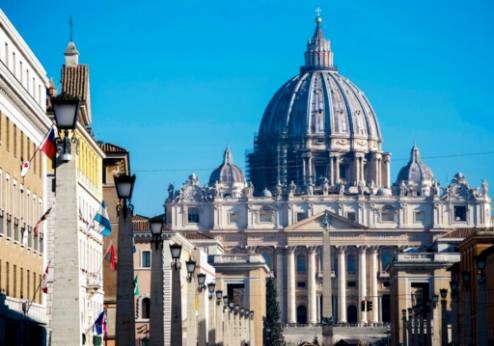St. Peter's Basilica stands as a testament to the grandeur and influence of Renaissance architecture, reflecting the patronage and funding of the papacy. Its construction not only symbolizes the power and authority of the Catholic Church but also reveals the political intrigues and power struggles that shaped its development.

Influence of Renaissance Architecture in St. Peter's Basilica Construction
St. Peter's Basilica is a prime example of Renaissance architecture, incorporating elements of classical Roman design with innovative new techniques and ideas. The influence of Renaissance architecture can be seen in the basilica's vast dome, harmonious proportions, and use of classical orders such as columns and pilasters. The architects of St. Peter's Basilica, including Bramante, Michelangelo, and Bernini, were all masters of the Renaissance style and their work on the basilica helped to define the era's architectural ideals.
The use of classical elements such as columns and arches in the design of St. Peter's Basilica reflects the Renaissance interest in rediscovering and emulating the architectural styles of ancient Rome. The basilica's façade, with its grand Corinthian columns and intricate detailing, is a testament to the architects' ability to blend the past with the present in a harmonious and visually striking way.
One of the most iconic features of St. Peter's Basilica is its massive dome, designed by Michelangelo. The dome's innovative design and engineering techniques, including the use of double shells and a unique ribbed construction, showcase the Renaissance emphasis on pushing the boundaries of what was possible in architecture. The dome not only serves as a testament to the skill and ingenuity of Renaissance architects, but also as a symbol of the era's quest for perfection and beauty in design.
Overall, the influence of Renaissance architecture on St. Peter's Basilica is evident in its harmonious proportions, classical elements, and innovative construction techniques. The basilica stands as a lasting testament to the skill and vision of the architects who designed it, as well as a reflection of the ideals and aesthetics of the Renaissance era.
Papal Patronage and Funding for St. Peter's Basilica
Papal Patronage and Funding for St. Peter's Basilica
The construction of St. Peter's Basilica was made possible through the generous patronage of several popes throughout the years. Pope Nicholas V was one of the first popes to contribute significant funding towards the project, laying the groundwork for future construction efforts. Pope Julius II continued the tradition of patronage, commissioning renowned artists such as Michelangelo to contribute to the grand design of the basilica. Pope Paul III also played a crucial role in securing funds for the construction, ensuring that the project would be completed according to the grand vision set forth by previous popes. Overall, the papal patronage and funding for St. Peter's Basilica were essential in bringing to life one of the most iconic architectural masterpieces in the world.
Impact of St. Peter's Basilica on the Catholic Church's Authority
St. Peter's Basilica holds immense significance in the Catholic Church and has played a vital role in shaping its authority throughout history. The construction and grandeur of the basilica have served as a symbol of the church's power and influence, both spiritually and politically. The magnificence of St. Peter's has attracted pilgrims and followers from all over the world, solidifying the church's status as a center of faith and worship. The sheer size and beauty of the basilica have also served to reinforce the notion of the church's divine authority and importance in the eyes of its followers. Furthermore, the presence of St. Peter's in the heart of the Vatican City has cemented the papacy's role as the highest authority in the Catholic Church, further enhancing its influence and standing in the world.
Political Intrigues and Power Struggles during St. Peter's Basilica Construction
Political Intrigues and Power Struggles during St. Peter's Basilica Construction
The construction of St. Peter's Basilica was not only a significant architectural project but also a complex political endeavor. During the construction of the basilica, there were various power struggles and intrigues that influenced the progress of the project. One of the main issues that arose was the competition among different architects and artists vying for control over the design and construction of the basilica. This led to conflicts and delays as various parties fought for influence and recognition.
Additionally, the involvement of powerful political figures, such as the popes and other members of the Catholic Church hierarchy, also played a role in shaping the direction of the project. These individuals often had conflicting interests and agendas, which led to disagreements and disputes over the funding and management of the construction process. The political maneuvering and power struggles between these various factions further complicated the already challenging task of building such a monumental structure.
Furthermore, the construction of St. Peter's Basilica was not immune to the broader political climate of the time. The Renaissance period was characterized by intense rivalries between different city-states, as well as the ongoing power struggles between various European monarchs and the papacy. This political context had a direct impact on the construction of the basilica, as rival factions sought to use the project to assert their influence and control over the Catholic Church.
In conclusion, the construction of St. Peter's Basilica was not just a feat of architectural brilliance but also a testament to the intricate political dynamics of the time. The power struggles and intrigues that characterized the project highlighted the complex interplay between art, politics, and religion during the Renaissance period. Ultimately, these political conflicts and rivalries shaped the development of one of the most iconic buildings in the world, reflecting the turbulent times in which it was built.
